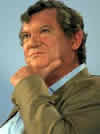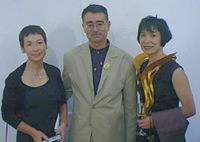 Robert Hughes |
Reflecting on this tendentious juxtaposition, Hughes worked his voice up into a patrician concern about the postmodern theatre of national identities. Does not this reduction in national identity leave us in the position of impecunious aristocrats selling tours of their family mansions to the hoi polloi? With an almost Bruce Ruxton anxiety about the yellow peril, Hughes warns his audience to resist cutting the cloth of Australian identity to suit our diminutive neighbours. |
 Mitsubishi |
BEFORE A THING
OF BEAUTY CAN BE MADE IN THE MATERIAL WORLD. FIRST IT MUST BE CONCEIVED IN THE HEART AND IN THE MIND Please Consider (Mitsubishi Ad) |
 Harold Stewart |
With exacting detail and rhyming metre, the works written in Japan paid homage to the sacred land of Buddhism. His strongest ally at home was A.D. Hope, who according to legend described Stewart’s major work, By the Old Walls of Kyoto, as ‘the best long poem in the English language’. Stewart kept up correspondence with a select group back in Australia, including James McAuley and the ceramicist Milton Moon, but he was a dogged exile. Until his deathbed, he did not show an interest in returning to Australia, which he referred to as the ‘land of was’. |
 Barry Leckenby |
If you search on the Internet today, you will find more material on Stewart’s religious philosophy than his poetry. The Mugeko site provides a focus for Shin Buddhism in the west. One of the contributors, Barry Leckenby, described Stewart’s belief in Shin Buddhism as ‘the quest to find a less prescriptive spirituality that exiled nobody from the paradisiacal afterlife’. Though it is possible see this as reflecting his attack of pretension during the Ern Malley hoax, it still doesn’t account for Stewart’s exotic conversion. |
 Jane Sawyer |
What Sawyer gained from her experience in Japan is an appreciation of skill. For her, skill is a means to obtain freshness in the work. ‘The more skilled you are at something, the easier it becomes and the fresher it is born. It grants you a certain level of spontaneity and playfulness, of being able to let go.’ For the Japanese, the main path towards spontaneity is repetition—making the same object over and over until the conscious mind lets go. ‘For me to sit down on a wheel and play with a lump of clay is the opposite of that.’ |
|
|
Cohn has been able to find a place in the Japanese market for one kind of work: her square mourning rings made from aluminium anodised in black. With use, the black surface suffers scratches and thus wears in a way that reflects the grieving process. These rings are popular at home as well, where they provide Australians with a device for experiencing a passage of time that might otherwise go unmarked. |
  Her Arnott’s biscuit tins (1994) delve into the sentimental heart of local material culture. Their distressed surface attempts to reflect the trials that a treasured object undergoes in retaining its contents—an expression of the Japanese wabi aesthetic of worn surfaces on a lost Australian icon. More recently, she has distressed tins of MSG to mark the loss of a particular kind of twentieth century condiment. |
|
 Les Murray |
"Christianity can co-exist with a good deal of Shinto, particularly perhaps a Shinto tempered by humour, because the two are about different spiritual concerns. The sort of Shinto that I am talking about is almost obsessed by style, by manners, but it has nothing to say about Last Things. On the other hand, it does fit in, in a way which ought to interest Christians, with the oldest spiritual traditions existing in Australia in its celebration, now formal, now casually familiar of special sites and objects and particularised animals held in emblematic, partially mythologised poses of contemplation," |
 Peter Sculthorpe |
"Sitting there, in bright sunlight, I felt very complete in myself. The shining world of Naiku had affected me in a profound way. Somehow, too, I’d come to feel like the kind of Australian that could be called Australian Asian." Rather than travel the path to authenticity, by stripping away Western culture and embracing the self-denial of Zen discipline, Sculthorpe finds a point of inauthenticity on which to attach himself |
 |
Despite appreciating their work, Kawanabe felt that Mono-Ha had no place for a woman like her. The only path was to join a group. ‘I had a physical reaction to that kind of society’ she says, ‘I wanted to let things out, not contain them.’ Europe offered a way out. In Munich, she was surprised to find a Japanese jeweller who prefaced her sentences with the words ‘I think …’—no woman in Japan would speak for herself like this. Back in Japan, this licence for self-expression was extended by a visiting teacher from Sydney College of the Arts (Mary Rose Sinn) who offered Kawanabe a means of visiting Australia. |
